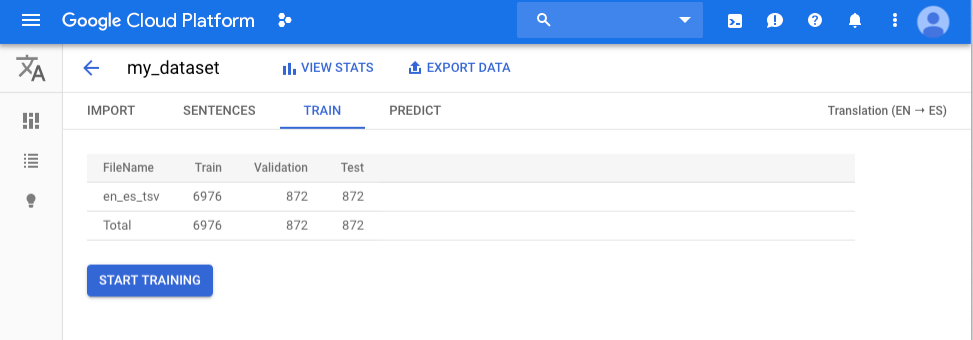训练模型
如果您拥有一个包含一组可靠的训练句对的数据集,就可以创建并训练自定义模型。
网页界面
-
数据集页面显示当前项目的可用数据集。
选择要用于训练自定义模型的数据集。
所选数据集的显示名会显示在标题栏中,该页面还会列出数据集中的各个训练项以及各自的“训练”“验证”或“测试”标签。
查看完数据集后,点击标题栏正下方的训练标签页。

点击开始训练。
将出现训练新模型对话框。
为模型指定名称。
点击开始训练以开始训练自定义模型。
训练模型可能需要几个小时才能完成。成功训练模型后,我们会向您注册程序时使用的电子邮件地址发送一封邮件。
REST
在使用任何请求数据之前,请先进行以下替换:
- project-id:您的 Google Cloud Platform 项目 ID
- model-name:新模型的名称
- dataset-id:数据集的 ID。此 ID 是数据集名称的最后一个元素。例如,如果数据集的名称为
projects/434039606874/locations/us-central1/datasets/3104518874390609379,则数据集 ID 为3104518874390609379。
HTTP 方法和网址:
POST https://automl.googleapis.com/v1/projects/project-id/locations/us-central1/models
请求 JSON 正文:
{
"displayName": "model-name",
"dataset_id": "dataset-id",
"translationModelMetadata": {
"base_model" : ""
}
}
如需发送您的请求,请展开以下选项之一:
您应该收到类似以下内容的 JSON 响应:
{
"name": "projects/project-number/locations/us-central1/operations/operation-id",
"metadata": {
"@type": "type.googleapis.com/google.cloud.automl.v1.OperationMetadata",
"createTime": "2019-10-02T18:40:04.010343Z",
"updateTime": "2019-10-02T18:40:04.010343Z",
"createModelDetails": {}
}
}
Go
如需了解如何安装和使用 AutoML Translation 客户端库,请参阅 AutoML Translation 客户端库。 如需了解详情,请参阅 AutoML Translation Go API 参考文档。
如需向 AutoML Translation 进行身份验证,请设置应用默认凭据。如需了解详情,请参阅为本地开发环境设置身份验证。
Java
如需了解如何安装和使用 AutoML Translation 客户端库,请参阅 AutoML Translation 客户端库。 如需了解详情,请参阅 AutoML Translation Java API 参考文档。
如需向 AutoML Translation 进行身份验证,请设置应用默认凭据。如需了解详情,请参阅为本地开发环境设置身份验证。
Node.js
如需了解如何安装和使用 AutoML Translation 客户端库,请参阅 AutoML Translation 客户端库。 如需了解详情,请参阅 AutoML Translation Node.js API 参考文档。
如需向 AutoML Translation 进行身份验证,请设置应用默认凭据。如需了解详情,请参阅为本地开发环境设置身份验证。
Python
如需了解如何安装和使用 AutoML Translation 客户端库,请参阅 AutoML Translation 客户端库。 如需了解详情,请参阅 AutoML Translation Python API 参考文档。
如需向 AutoML Translation 进行身份验证,请设置应用默认凭据。如需了解详情,请参阅为本地开发环境设置身份验证。
其他语言
C#:请按照客户端库页面上的 C# 设置说明操作,然后访问 .NET 版 AutoML Translation 参考文档。
PHP:请按照客户端库页面上的 PHP 设置说明操作,然后访问 PHP 版 AutoML Translation 参考文档。
Ruby:请按照客户端库页面上的 Ruby 设置说明操作,然后访问 Ruby 版 AutoML Translation 参考文档。
获取操作状态
如需检查长时间运行的任务(将训练项导入数据集或训练模型)的状态,您可以使用在开始执行该任务时所收到响应中的操作 ID。
您只能使用 AutoML API 检查操作的状态。
如需获取训练操作的状态,您必须向 operations 资源发送 GET 请求。下面演示了如何发送此类请求。
在使用任何请求数据之前,请先进行以下替换:
- operation-name:在对 API 的原始调用的响应中返回的操作名称
- project-id:您的 Google Cloud Platform 项目 ID
HTTP 方法和网址:
GET https://automl.googleapis.com/v1/operation-name
如需发送您的请求,请展开以下选项之一:
您应该收到类似以下内容的 JSON 响应:
{
"metadata": {
"@type": "type.googleapis.com/google.cloud.automl.v1.OperationMetadata",
"createTime": "2019-10-01T22:13:48.155710Z",
"updateTime": "2019-10-01T22:13:52.321072Z",
...
},
"done": true,
"response": {
"@type": "resource-type",
"name": "resource-name"
}
}
取消操作
您可以使用操作 ID 取消导入任务或训练任务。
在使用任何请求数据之前,请先进行以下替换:
- operation-name:操作的完整名称。完整名称的格式为
projects/project-id/locations/us-central1/operations/operation-id。 - project-id:您的 Google Cloud Platform 项目 ID
HTTP 方法和网址:
POST https://automl.googleapis.com/v1/operation-name:cancel
如需发送您的请求,请展开以下选项之一:
您应该会收到一个成功的状态代码 (2xx) 和一个空响应。
管理模型
获取模型的相关信息
训练完成后,您可以获取有关新创建的模型的信息。
本部分中的示例返回模型的基本元数据。要获取有关模型准确率和就绪情况的详细信息,请参阅评估模型。
REST
在使用任何请求数据之前,请先进行以下替换:
- model-name:模型的完整名称。模型的完整名称包括您的项目名称和位置。模型名称类似于以下示例:
projects/project-id/locations/us-central1/models/model-id。 - project-id:您的 Google Cloud Platform 项目 ID
HTTP 方法和网址:
GET https://automl.googleapis.com/v1/model-name
如需发送您的请求,请展开以下选项之一:
您应该收到类似以下内容的 JSON 响应:
{
"name": "projects/project-number/locations/us-central1/models/model-id",
"displayName": "model-display-name",
"datasetId": "dataset-id",
"createTime": "2019-10-01T21:51:44.115634Z",
"deploymentState": "DEPLOYED",
"updateTime": "2019-10-02T00:22:36.330849Z",
"translationModelMetadata": {
"sourceLanguageCode": "source-language",
"targetLanguageCode": "target-language"
}
}
Go
如需了解如何安装和使用 AutoML Translation 客户端库,请参阅 AutoML Translation 客户端库。 如需了解详情,请参阅 AutoML Translation Go API 参考文档。
如需向 AutoML Translation 进行身份验证,请设置应用默认凭据。如需了解详情,请参阅为本地开发环境设置身份验证。
Java
如需了解如何安装和使用 AutoML Translation 客户端库,请参阅 AutoML Translation 客户端库。 如需了解详情,请参阅 AutoML Translation Java API 参考文档。
如需向 AutoML Translation 进行身份验证,请设置应用默认凭据。如需了解详情,请参阅为本地开发环境设置身份验证。
Node.js
如需了解如何安装和使用 AutoML Translation 客户端库,请参阅 AutoML Translation 客户端库。 如需了解详情,请参阅 AutoML Translation Node.js API 参考文档。
如需向 AutoML Translation 进行身份验证,请设置应用默认凭据。如需了解详情,请参阅为本地开发环境设置身份验证。
Python
如需了解如何安装和使用 AutoML Translation 客户端库,请参阅 AutoML Translation 客户端库。 如需了解详情,请参阅 AutoML Translation Python API 参考文档。
如需向 AutoML Translation 进行身份验证,请设置应用默认凭据。如需了解详情,请参阅为本地开发环境设置身份验证。
其他语言
C#:请按照客户端库页面上的 C# 设置说明操作,然后访问 .NET 版 AutoML Translation 参考文档。
PHP:请按照客户端库页面上的 PHP 设置说明操作,然后访问 PHP 版 AutoML Translation 参考文档。
Ruby:请按照客户端库页面上的 Ruby 设置说明操作,然后访问 Ruby 版 AutoML Translation 参考文档。
列出模型
一个项目可以包含许多模型。本部分介绍如何检索项目的可用模型列表。
网页界面
要使用 AutoML Translation 界面查看可用模型的列表,请点击左侧导航栏中的灯泡图标。

要查看其他项目的模型,请从标题栏右上角的下拉列表中选择该项目。
REST
在使用任何请求数据之前,请先进行以下替换:
- project-id:您的 Google Cloud Platform 项目 ID
HTTP 方法和网址:
GET https://automl.googleapis.com/v1/projects/project-id/locations/us-central1/models
如需发送您的请求,请展开以下选项之一:
您应该收到类似以下内容的 JSON 响应:
{
"model": [
{
"name": "projects/project-number/locations/us-central1/models/model-id",
"displayName": "model-display-name",
"datasetId": "dataset-id",
"createTime": "2019-10-01T21:51:44.115634Z",
"deploymentState": "DEPLOYED",
"updateTime": "2019-10-02T00:22:36.330849Z",
"translationModelMetadata": {
"sourceLanguageCode": "source-language",
"targetLanguageCode": "target-language"
}
}
]
}
Go
如需了解如何安装和使用 AutoML Translation 客户端库,请参阅 AutoML Translation 客户端库。 如需了解详情,请参阅 AutoML Translation Go API 参考文档。
如需向 AutoML Translation 进行身份验证,请设置应用默认凭据。如需了解详情,请参阅为本地开发环境设置身份验证。
Java
如需了解如何安装和使用 AutoML Translation 客户端库,请参阅 AutoML Translation 客户端库。 如需了解详情,请参阅 AutoML Translation Java API 参考文档。
如需向 AutoML Translation 进行身份验证,请设置应用默认凭据。如需了解详情,请参阅为本地开发环境设置身份验证。
Node.js
如需了解如何安装和使用 AutoML Translation 客户端库,请参阅 AutoML Translation 客户端库。 如需了解详情,请参阅 AutoML Translation Node.js API 参考文档。
如需向 AutoML Translation 进行身份验证,请设置应用默认凭据。如需了解详情,请参阅为本地开发环境设置身份验证。
Python
如需了解如何安装和使用 AutoML Translation 客户端库,请参阅 AutoML Translation 客户端库。 如需了解详情,请参阅 AutoML Translation Python API 参考文档。
如需向 AutoML Translation 进行身份验证,请设置应用默认凭据。如需了解详情,请参阅为本地开发环境设置身份验证。
其他语言
C#:请按照客户端库页面上的 C# 设置说明操作,然后访问 .NET 版 AutoML Translation 参考文档。
PHP:请按照客户端库页面上的 PHP 设置说明操作,然后访问 PHP 版 AutoML Translation 参考文档。
Ruby:请按照客户端库页面上的 Ruby 设置说明操作,然后访问 Ruby 版 AutoML Translation 参考文档。
删除模型
以下示例演示了如何删除模型。
网页界面
在 AutoML Translation 界面中,点击左侧导航菜单中的灯泡图标以显示可用模型列表。

点击待删除行最右侧的三点状菜单,然后选择删除模型。
在确认对话框中点击删除。
REST
在使用任何请求数据之前,请先进行以下替换:
- model-name:模型的完整名称。模型的完整名称包括您的项目名称和位置。模型名称类似于以下示例:
projects/project-id/locations/us-central1/models/model-id。 - project-id:您的 Google Cloud Platform 项目 ID
HTTP 方法和网址:
DELETE https://automl.googleapis.com/v1/model-name
如需发送您的请求,请展开以下选项之一:
您应该收到类似以下内容的 JSON 响应:
{
"name": "projects/project-number/locations/us-central1/operations/operation-id",
"metadata": {
"@type": "type.googleapis.com/google.cloud.automl.v1beta1.OperationMetadata",
"progressPercentage": 100,
"createTime": "2018-04-27T02:33:02.479200Z",
"updateTime": "2018-04-27T02:35:17.309060Z"
},
"done": true,
"response": {
"@type": "type.googleapis.com/google.protobuf.Empty"
}
}
Go
如需了解如何安装和使用 AutoML Translation 客户端库,请参阅 AutoML Translation 客户端库。 如需了解详情,请参阅 AutoML Translation Go API 参考文档。
如需向 AutoML Translation 进行身份验证,请设置应用默认凭据。如需了解详情,请参阅为本地开发环境设置身份验证。
Java
如需了解如何安装和使用 AutoML Translation 客户端库,请参阅 AutoML Translation 客户端库。 如需了解详情,请参阅 AutoML Translation Java API 参考文档。
如需向 AutoML Translation 进行身份验证,请设置应用默认凭据。如需了解详情,请参阅为本地开发环境设置身份验证。
Node.js
如需了解如何安装和使用 AutoML Translation 客户端库,请参阅 AutoML Translation 客户端库。 如需了解详情,请参阅 AutoML Translation Node.js API 参考文档。
如需向 AutoML Translation 进行身份验证,请设置应用默认凭据。如需了解详情,请参阅为本地开发环境设置身份验证。
Python
如需了解如何安装和使用 AutoML Translation 客户端库,请参阅 AutoML Translation 客户端库。 如需了解详情,请参阅 AutoML Translation Python API 参考文档。
如需向 AutoML Translation 进行身份验证,请设置应用默认凭据。如需了解详情,请参阅为本地开发环境设置身份验证。
其他语言
C#:请按照客户端库页面上的 C# 设置说明操作,然后访问 .NET 版 AutoML Translation 参考文档。
PHP:请按照客户端库页面上的 PHP 设置说明操作,然后访问 PHP 版 AutoML Translation 参考文档。
Ruby:请按照客户端库页面上的 Ruby 设置说明操作,然后访问 Ruby 版 AutoML Translation 参考文档。

